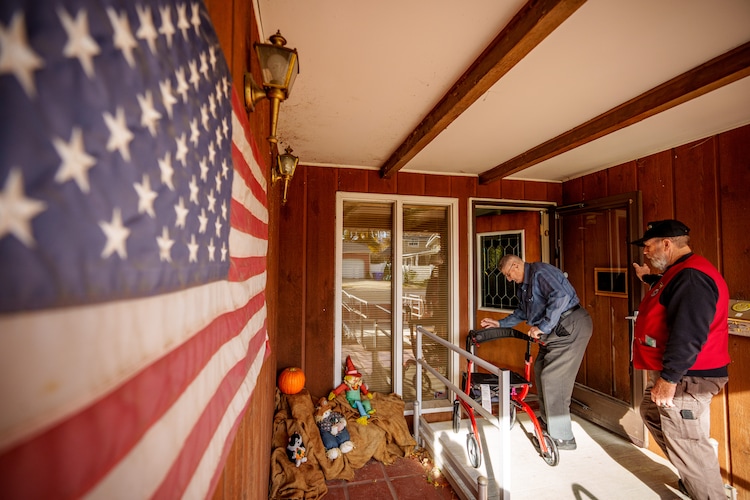Naval veteran Hal Bartlett is “a young 91” years old, as he put it, and relies on volunteers to drive him to appointments across Salt Lake City’s Veterans Affairs Health Care System to get medical help with bone damage, knee issues and other medical concerns.
If it weren’t for those volunteer drivers, he’d be stuck.
“There was no way of getting there, unless I had to hitchhike,” he said.

(Trent Nelson | The Salt Lake Tribune) Steve Herrmann, at right, assists veteran Hal Bartlett at his Bountiful home on Wednesday, Nov. 13, 2024.
To help veterans with travel limitations, V.A. Salt Lake City for years has worked with the Disabled American Veterans Transportation Network, offering free transport to and from medical appointments with the help of volunteer drivers.
The network operates with eight paid drivers and only has about five volunteer drivers available these days. But when as the weather grows colder and some drivers leave for warmer places, that number of volunteers can drop to three, said Mitchell Carter, who manages the veteran transportation program.
He estimates he needs at least 30 to meet “dire” demands.
The need is most prominent in the Wasatch Front, though it stretches over the 125,000 square miles that V.A. Salt Lake City covers, Carter said.
The increased need, Carter believes, comes from a growing population of veterans and growing awareness about the transportation program.
“It’s one of the only options that the V.A. provides for the non-service connected veterans,” Carter said, referencing veterans who never applied for benefits but enrolled in the V.A.’s care.
Veterans who suffered ailments during their service that the government then classifies as at least 30% disabling qualify for travel reimbursements. But other veterans who can’t afford the trip could miss vital care.
“We used to have a very robust volunteer program,” Carter said.
Prior to the COVID-19 pandemic and the health concerns that came with it, he said the program had about 50 volunteers. “What we have left is like a skeleton crew.”
(Trent Nelson | The Salt Lake Tribune) A vehicle used to transport veterans to the V.A.'s George E. Wahlen Department of Veterans Affairs Medical Center in Salt Lake City on Wednesday, Nov. 13, 2024.
Carter said he mostly sees the transportation program being utilized by older veterans with fixed and sometimes low incomes, though it’s available to all enrolled in care and even some current service members in certain circumstances.
If it weren’t for the program, he said many of them likely wouldn’t be able to access the medical care their military service qualifies them for.
“There‘s a lot of veterans that, if we’re not able to get them in, they don’t have family or they don’t have anyone else to assist them,” he said. “They don’t have any other resources that they know about or utilize.”
And, as a veteran himself, Carter knows the importance of the benefits service members qualify for after they are discharged.
(Trent Nelson | The Salt Lake Tribune) Steve Herrmann assists veteran Hal Bartlett at his Bountiful home on Wednesday, Nov. 13, 2024.
“You can’t get your medical care if you can‘t access it,” he said. “Transportation, in my opinion, is the first part to your care. ... It’s a huge benefit to the veterans, because they sacrificed a lot for their country, including their health and well-being. And so it is huge that the V.A. is able to offer health care to these people.“
As veterans age, they may start utilizing V.A. care even more as their incomes are fixed and medical expenses are not, Carter said.
People interested in volunteering to help transport veterans can find more information about how to do so at the V.A. Salt Lake City website.
The Salt Lake City V.A. health system encompasses 10 community clinics across three states, including the local George E. Wahlen Department of Veterans Affairs Medical Center. It provides health care to more than 70,000 eligible veterans.
(Trent Nelson | The Salt Lake Tribune) Steve Herrmann assists veteran Hal Bartlett at his Bountiful home on Wednesday, Nov. 13, 2024.








